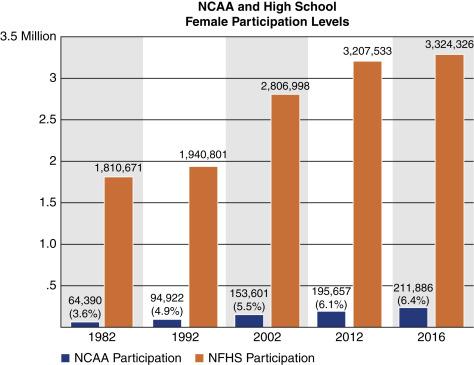Physical Address
304 North Cardinal St.
Dorchester Center, MA 02124
The passage of Title IX is arguably the most important event in the timeline of women’s participation in US athletic endeavors. By almost any measure, the numbers of female athletes have exploded in multiple sports in the decades since 1972.
“No person in the United States shall, on the basis of sex, be excluded from participation in, or denied the benefits of, or be subjected to discrimination under any educational program or activity receiving federal assistance.” Title IX of the Education Amendments of 1972 to the Civil Rights Act of 1964.
Before Title IX, approximately 1 in 27 girls participated in college sports; that number today is greater than 1 in 2. The National Collegiate Athletic Association (NCAA) tracks women’s sports participation in its member institutions; the data are self-reported and are useful for evaluating general trends. In 1981, total athletes numbered 74,239. By 1993, the total had risen to 105,532 and then in 2016 to over 200,000. In general, the increase in participation reflects the addition of women’s teams to institutions. The increase also reflects the elevation to NCAA championship sport status of sports such as ice hockey, water polo, and bowling. Additional emerging sports, such as equestrian, triathlon, and beach volleyball, also have increased the numbers of female athletes ( Fig. 28.1 ).

The increase in the number of women participating in sports and the increase in their level of competition has provided a new opportunity to study the effects of different sports on the female athlete. Some sports provide the opportunity to directly compare injury rates for both genders. Other sports are the exclusive domain of the female athlete. Prevention of injuries, whether sport specific or gender specific, has been a primary focus in sports medicine. The sports identified as causing the highest number of injuries in the female athlete are basketball, volleyball, field hockey, and gymnastics. Sports played on artificial turf, such as women’s soccer and lacrosse, now have a higher rate of ankle injuries and turf toe.
Men and women have slightly different physical attributes, which have advantages and disadvantages. For example, women’s lower extremities constitute less of their total height, which lowers their center of gravity and makes them more amenable to tasks such as the balance beam. Moreover, women’s androgenic makeup promotes maintenance of a higher percentage of body fat, which is less desirable in sports such as cross-country. Care of the female athlete must be grounded in awareness of the Female Athlete Triad, which is a spectrum of decreased energy availability, menstrual dysfunction and low bone mass.
When approaching the study of foot and ankle problems in female athletes, disorders can be divided into sport/activity-specific disorders and gender-specific physiologic considerations.
The female gymnast is at higher risk for ankle injury than the male gymnast. Areas of complaint in the foot in female gymnasts include the bottom of the heel, the plantar fascia origin, and the medial longitudinal arch. Direct blows during landings or striking the heel on the floor while swinging under the lower uneven parallel bar cause pain under the heel. Tumbling is the typical cause of pain at the origin of the plantar fascia, whereas landings cause pain in the medial longitudinal arch or the forefoot. Interestingly, analysis of flexibility parameters in gymnasts compared with controls does not demonstrate a correlation to injury patterns or frequency. Ankle impingement syndrome (see Chapter 2 ) occurs in the female gymnast, with impingement occurring anteriorly when she lands short on her dismount, forcing her ankle into hyper dorsiflexion. If acute pain occurs with an instance of injury, the ankle should be rested and iced. Physical therapy modalities and antiinflammatory drugs are useful adjuncts.
Become a Clinical Tree membership for Full access and enjoy Unlimited articles
If you are a member. Log in here